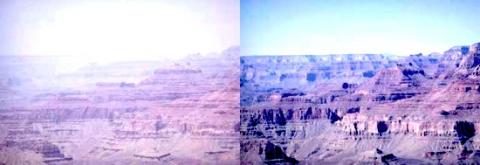Debate over the country's energy needs, environmental conditions, and the resulting quality of life is not new. It's unending, ongoing, and downright rancorous at times. But does it need to be? With hazy views across spectacular parks in the Southwest, how can we turn that debate into solutions?
Stand on the North or South rims of Grand Canyon National Park, at Rainbow Point in Bryce Canyon National Park, or on the mesa top of Mesa Verde National Park and too often these days the views are obscured, clouded with emissions from the coal-fired Navajo Generating Station and Four Corners Power Plant.
Trying to catch the Obama administration's attention on this issue, the National Parks Conservation Association today released a video that shows some of the air-quality woes and also offers interviews with some folks who live in the Four Corners area and believe we're losing valuable time in addressing the problem.
Specifically, NPCA wants the administration, through the Environmental Protection Agency, to "require reductions in coal plant air pollution that will benefit people and our national parks."
Watch the following video, then consider sending your thoughts to President Obama by May 7 asking him to require the EPA to reduce coal plant air pollution in the Southwest.
Air-quality problems are not restricted to these parks. According to the National Park Service, "deteriorating air quality due to high pollutant levels of ozone and particulate matter cause the National Park Service to issue air quality health advisories at several national parks. These parks include Acadia, Grand Canyon, Great Smoky Mountains, Mammoth Cave, Rocky Mountain, Sequoia/Kings Canyon, and Shenandoah national parks."
"Both ozone and particulate matter concentrations in National Park Service areas periodically exceed Environmental Protection Agency health standards. Whenever ozone or particulate matter concentrations exceed or are predicted to exceed these health standards, park personnel post health advisories cautioning visitors of the potential health risks associated with exposures to elevated levels," the agency notes on its air quality web page.
As timing would have it, on April 8 there will be a joint congressional hearing at the Shrine of the Ages in Grand Canyon National Park to discuss the park’s environmental future. David Nimkin, NPCA's Southwest regional director, Bill Hedden, executive director of the Grand Canyon Trust, and Carletta Tilousi, a member of the Havasupai Tribe, will be among those testifying before members of the House Subcommittee on National Parks, Forests and Public Lands and the Subcommittee on Water and Power on the threats posed by uranium mining, management of the Colorado River through the Canyon, and other issues.
If you can claim any of the congressfolk on those committees, you might consider giving them your thoughts on the air-quality issues in the National Park System.


 Support Essential Coverage of Essential Places
Support Essential Coverage of Essential Places






